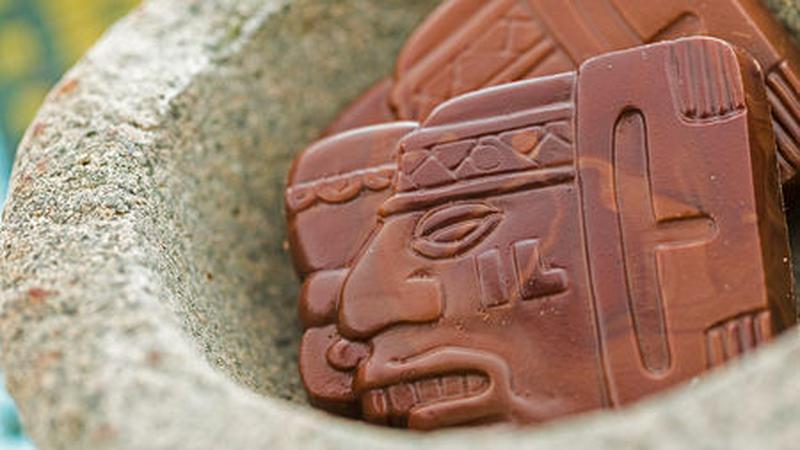Xocolatl: The Mayan Food Of The Gods
By | April 10, 2019

We have the Mayans to thank for giving us one of our favorite guilty pleasures, chocolate. Archaeologists believe that chocolate, or Xocolatl, as the Mayans called it, was cultivated as early as 900 AD in Mesoamerica. The Mayans, and later the Aztecs, made a beverage from the beans of the cocoa pods that was used for a popular, everyday drink but also used in rituals and healing practices. The beverage was a far cry from the sweetened hot chocolate that we enjoy today. Let’s look at the traditional xocolatl drink, the Mayan food of the Gods.

The Mayan’s ‘Bitter Water’
We take the present-day word ‘chocolate’ from the Mayan word ‘xocolatl’, which translates to mean ‘bitter water.’ And that is an accurate description of the traditional Mayan chocolate beverage. The Mayans did not cultivate sugar cane so they had no means of sweetening the bitter cocoa beans. They made the drink by crushing the cocoa beans, then adding chili peppers and water. Before serving it, they would rapidly pour it from one cup into another until a frothy foam formed on the top, like some of today’s Starbucks drinks.

Chocolate was a Gift From the Gods
The Mayans believed that chocolate was a gift to humans from the gods and, therefore, should be shared with all of the people. Anyone in the Mayan civilization could partake of the beverage, regardless of their social standing. The Mayans consumed xocolatl on a daily basis, much like how we drink our morning coffee. That changed drastically when the Mayan civilization gave way to the Aztecs. The Aztec people did not grow their own cocoa beans and had to trade for the beans. Therefore, they placed a higher value on the xocolatl drink. Only the very wealthy, the royalty, and the high priests could afford to drink it. In fact, the beverage was so valued that it was served in goblets made of gold that were discarded after just one use.

Chocolate Money
Neighboring civilizations established trade with the Mayans for the precious cocoa beans. From this, the beans eventually became a form of currency for the Mayans. The beans were used to pay for goods and services. For example, a pumpkin sold for four cocoa beans and a prostitute cost ten beans. When the Aztecs conquered the Mayans, they forced the Mayans to pay high taxes to them in the form of cocoa beans. The valuable beans were kept under lock and key and, yes, there was a thriving counterfeit cocoa bean underground network.

Chocolate Rites
Both the Mayan and the Aztec used xocolatl in rituals. The drink was thought to have the power to alter the brain and open the mind to the spirit world. The festival honoring Ek Chauh, the Mayan cocoa god, was an annual event that included offerings of cocoa beans, blood sacrifices, ritual dancing, and more. Similarly, the Aztecs had a yearly cocoa festival, held at their capital, Tenochtitlan, that included the sacrifice of a warrior from an enemy tribe as a way to honor the god who gifted mortals with the cocoa bean.

Chocolate for Weddings and Births
Cocoa beans played a role during Mayan wedding ceremonies. A mixture of crushed cocoa beans, combined with crushed corn gruel, was served in a ceremonial clay jug to be used during the wedding. Before the Spanish conquistadors converted the Mayan people to Catholicism, the Mayans would anoint the heads of newborn babies with a mixture of ground cocoa seeds, flowers, and clear water.

Chocolate for the Health of It
The ancient cultures of Mesoamerica believed in the healing power of chocolate. It was used to cure or treat a wide range of ailments, from asthma, angina, cancer, and anemia, to fatigue, headaches, fever, and laryngitis. Chocolate was believed to soothe upset stomachs and help wounds heal faster. Aztec warriors drank xocolatl before going into battle because they thought it would give them increased strength and courage. The Aztec king, Montezuma, was said to guzzle 50 goblets of xocolatl before visiting his harem to give him the stamina to romance several ladies in one night.

The Spanish and Chocolate
The Spanish conquistadors who invaded Mesoamerica and defeated the Aztec empire were introduced to the xocolatl beverage but were unimpressed. They found the drink to be bitter and nearly unpalatable. They hesitated to even bring the cocoa beans back to Europe with them. When they did, however the Spanish monks found that they could make the drink more pleasant by adding sugar to it, giving us the sweetened chocolate that we all love and crave today.

